I recently saw a great group show, At the Edges at Angus-Hughes gallery on a subject that interests me greatly; Landscape and how we view the landscape. The choice of artists was particularly strong and the work linked in seamlessly and without fuss. I loved the work and recommend it thoroughly. It's not on for long though!
To accompany the show, the artists have produced a text which is written by the contemporary British painter Graham Crowley. Anything that connects the Clangers to Wittgenstein and Constable to the Beatles needs another airing so I asked Graham for permission to publish it on Huffington Post UK which he kindly agreed to.
Say what you see...
It is the soul that sees, the outward eyes. Present the object, but the mind decries - John Constable.
At the Edges invites us to reconsider our experience of landscape. It asks us to see landscape as something transient. Something unstable, elusive and fragile. But what is it that we're At the Edges of exactly?
The edge of an established genre? Almost certainly. But what's more likely and much more significant is that this exhibition is located at the edge of a discourse. A discourse that is painting. Painting isn't merely an activity or a set of objects, it's a discourse. A discourse in which we attempt to re-imagine the world and our place in it. And what better 'place' to undertake this than 'in' the landscape?
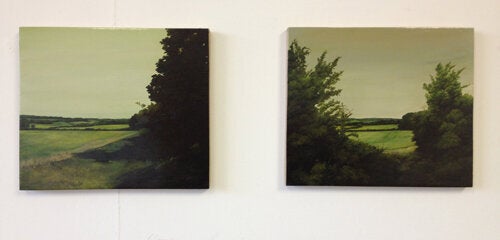
Hannah Brown
This is a show in which the small becomes large and where the familiar becomes unfamiliar. Where the frame unravels and where the ground becomes a distant memory. Jane Ward presents us with a vertiginous and scary-beautiful world. But this world exists as an exquisite fiction - familiar but somehow other. Is this light a kind of bliss - or oblivion? The last few white-hot seconds of nuclear blast? Or the Rapture; the end of days when the faithful are consumed by a tsunami of light and drawn up to heaven? Perhaps this is where the light of the landscape meets "the light that is memory" - the engram - the faintest and most fugitive of memories? Perhaps.
What we cannot speak about we must pass over in silence - Ludwig Wittgenstein.
At the Edges celebrates the exquisite. A 'place' where reflection, commonly associated with the experience of landscape, actually becomes a part of the work as in the work of Gary Colclough. This exhibition addresses itself at what is usually regarded as an undemanding and exhausted genre of painting. Conventional thinking also holds that landscape isn't a genre usually associated with sculpture. However, Boo Ritson has done just that by referencing elements of the diorama.
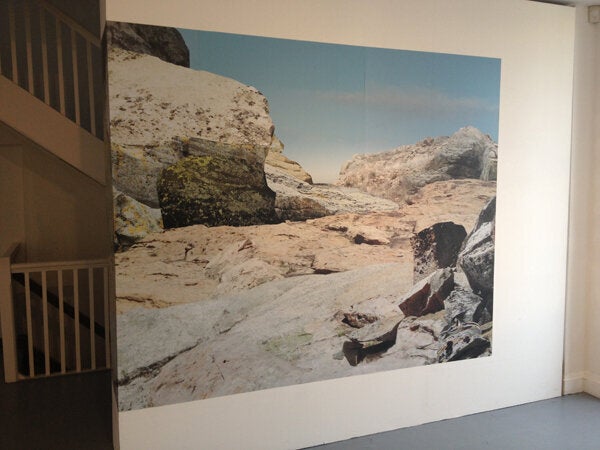
Boo Ritson
The diorama was a method of display commonly used in museums as a didactic tool. that was until technology rendered them obsolete. Here the diorama is employed as a platform for memory. A similar 'technology' and sensibility that gave us the wonderful TV programmes of Ivor Postgate and Peter Firkin - The Clangers et al. Innovation and invention.
This has allowed her to introduce both utilitarian and vernacular elements to inform her work. This has lent her work a sense of something that is both familiar and unfamiliar. Boo Ritson's constantly innovative approach modifies our sense of the aesthetic. The method? All the artists in this show have a similar approach; one which can be described as post-conceptual - rigorous, precise and insightful. These are not the routine claims of 'sense of place' or a casual opportunity to express oneself. Their work has that wonderful 'look stranger' quality. Where am I?
A site where fiction meets furniture. Where walls aren't simply a pragmatic solution to displaying the work. Hannah Brown's exquisite paintings, with their almost 'airtight' surface, rely upon our sense of the mimetic. She offers us familiar memories, connections and boundaries; we do the rest. Being in the landscape is an immersive experience. It's this sense of immersion that all of the artists involved in At the Edges bring to their work.
I am anxious that the world should be inclined to look to painters for information about painting - John Constable.
The exquisite relies on attention to detail and knowledge. It also demands skill, something that's in short supply. The assumptions that give credence to actualism are banished. Expression can take many forms. Expressionism however, is seen primarily as rhetoric these days. If there's anything left to say about landscape, it has to involve insight. Hannah Brown's still and exquisite paintings have a quiet authority about them that reminds me of the paintings of Giorgio Morandi. In the current multi-media-malestrom it's a high risk strategy to 'speak' so softly but that's what makes Hannah Brown's work so ambitious. The subtleties, the play with the familiar and the sense of inference, imbue her work with a sense that something is awry. The sense of 'did she or didn't she?' and a general sense of unease are reminiscent of William Trevor's memorable collection of short stories, entitled "The Hill Batchelors". Trevor is a master of ambiguity and inference. And like Trevor, Hannah Brown employs a sense of unease and menace. Ambiguity is a powerful tool - not to be confused with vagary which is what happens when concentration lapses.
I am showing my pupils details of an immense landscape which they cannot possibly know their way around - Ludwig Wittgenstein.
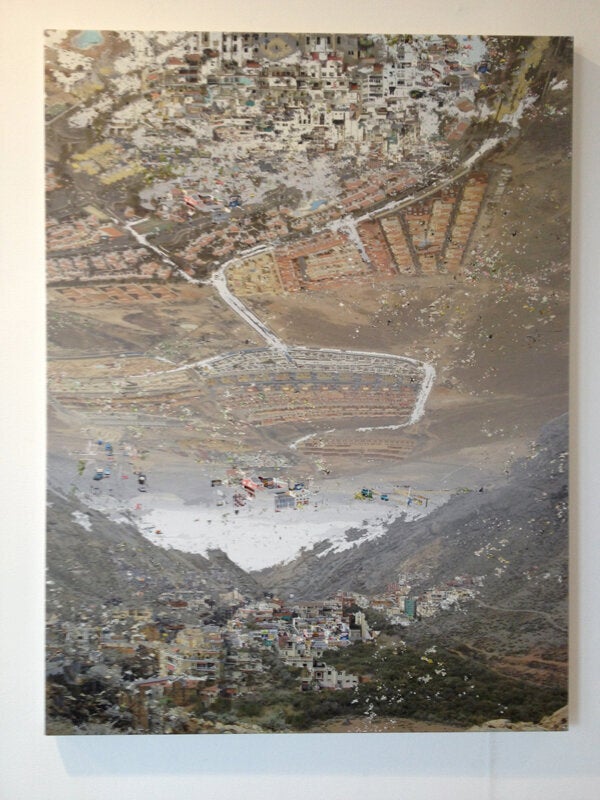
Jane Ward
The atomised or vapourising sense of image that Jane Ward employs is reminiscent of the last five minutes of Michelangelo Antonioni's film Zabriskie Point. Devastating. Jane Ward's work isn't simply disorientating; it's as if an alien had visited earth and had to describe it using other-worldly language. Her manipulated images resist our expectations. Nothing is still. Nothing is resolved and nothing is finite. The sense of being 'adrift' has seldom been realised as powerfully without resorting to depictions of violent or aberrant behaviour. Jane Ward's world is as distant and intangible as George Herrimann's wonderful Kokomo County, the home of Krazy Kat and Ignatz Mouse. Herrimann's landscape is never the same in any two consecutive frames. Ward's world.
An artist who is self taught is taught by a very ignorant person indeed - John Constable.
Most depictions of landscape refer implicitly to not one but two locations. The 'place' or 'view' and the other the 'viewer' or the place from which the viewing takes place. This is reciprocity. Sounds simple enough but reciprocity is the psychological cement that maintains society. Reciprocity relies upon imagination and empathy. Empathy is the ability to understand what it is to be other. An act of generosity? Definitely.
I am you, as you are me as we are all together. I am the walrus - Lennon & McCartney
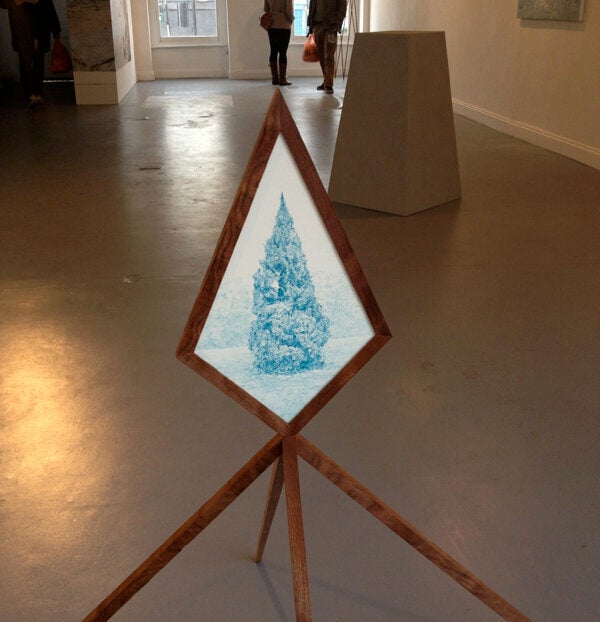
Gary Colclough
At the Edges is a celebration of curiosity and the incongruous. Boo Ritson makes the most elegant and precient landscapes that start as photographs of her back garden in Chesham, deep in Metroland. But once cut and collaged they take on the appearance of the Atacama Desert. Buckinghamshire becomes the Andes. Climate change takes on a new meaning - without recourse to didacticism or moralising. Second order meaning - the referencing of other paintings, sculpture, films, television, books and photographs in an artwork. Became a central tennet of post modernism. It has come to dominate academic painting over the past 30 years. Anyone attempting to refer to their direct experience - or first order meaning - is regarded as naive and marginalised. This is academic orthodoxy and like all orthodoxies is becoming dogma. Reclamation is what distinguishes this show. The precision of Gary Colclough's work is simply breath-taking. The curious mixture of exquisite pencil drawings, scientific grade mirrors and veiled references to sacred and Islamic geometry produce objects that reflect cultural pluralism. Once again, a 'small still voice' that has assumed a disproportionate sense of authority. A small wonder in a 'big cold world'. A clear testimony to reflection and concentration, without which they wouldn't exist. Gary Colclough's work displays a strong sense of simile. This means that it's hard to resist the temptation to see his work as 'reminiscent'. But like so much else in the show, it's a synthesis.
Talking to a lawyer about pictures is something like talking to a butcher about humanity - John Constable.
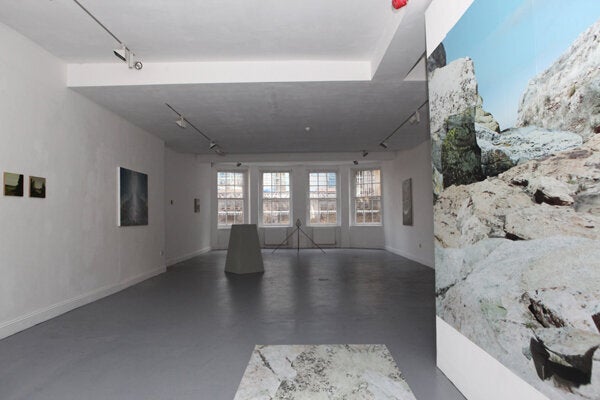
Installation Image courtesy of Angus-Hughes Gallery
At the Edges draws on a panoply of contemporary practice. After the hell of the First World War the early 1920's there was a 'return to order'. This was apparent in the neo-classicsm of Picasso and Leger. Similarly, a sense of re-evaluation is evident in this exhibition. This is demonstrated in the commanding display of intelligent and exquisite precision, reflective skepticism and common or garden curiosity. Hannah Brown's trig points recontextualize her painting. Jane Ward's manipulated photographs are 'expanded' by the analogue. She embraces the idea of tactility and all it's anthropomorphic connotations. Touch is usually regarded as something alien to the digital. Boo Ritson's re-imagining of the diorama and the vernacular tradition are fascinating. Gary Colclough's work conflates elements of the gothic with twentieth century minimalism. His tiny drawings are invariably monochromatic, this lends the work a sense of being 'in progress' or provisional because it is reminiscent of four colour separation in which only the first colour has been laid down. Contingency. Gary Colclough's work also seems to reference esoteric or ritual objects like the 'prayer batteries' of The Aetherius Society. The connections abound - incessantly. Naming things is habitual but attributing value and meaning is quite another matter. At the End.
I am going outside and may be some time - Captain Lawernce Oates.
© Graham Crowley.
London 2013.
At the Edges continues at Angus-Hughes Gallery until 31 March
